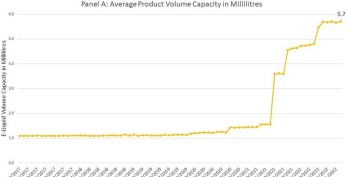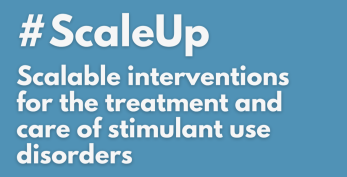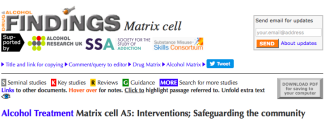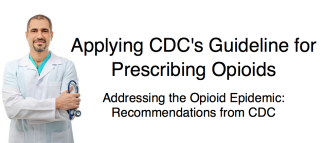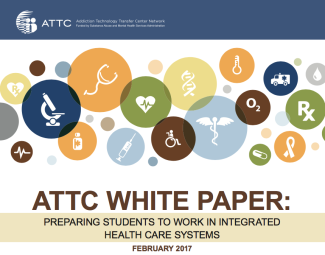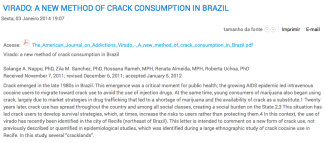Search
Public health
The intersection of substance use with broader public health concerns.
Do α2-Adrenergic Agonists Decrease the Symptoms Associated With Opioid Withdrawal?
Study Selection
This systematic review included randomized controlled clinical trials that compared the administration of an α2-adernergic agonist with other interventions such as placebo or methadone to reduce symptoms of opioid...
Estimating the Cost-Effectiveness of Brief Interventions for Heavy Drinking in Primary Health Care across Europe
Background
Screening and brief interventions for alcohol are an effective public health measure to tackle alcohol-related harm, however relatively few countries across the European Union (EU) have implemented them widely. This may be due...
Non-Medicinal Ritalin Use: Study Enhanced, But Taking a Chance
New research published in the Journal of Neural Transmission highlights a number of potential adverse side-effects from using the stimulant drug Ritalin without a prescription. Ritalin (Methylphenidate) is medically used to treat Attention...
Effectiveness Bank Matrix Bite: Treatment not for the Patient but for the Community
The final row of the Alcohol Treatment Matrix enters the domain of treatment organised not primarily for the patient, but to safeguard the wider community, encountering what seems a core contradiction depicted on the cover of WHO guidance...
Gender-Specific Predictors of At-Risk Adolescents’ Hazardous Alcohol Use
Abstract
Background
Previous research has found strong associations between adolescents’ hazardous alcohol use and their perception of peer behavior, as well as own spending money and a range of antisocial behaviors. However, there is...
The European Drinking Table: Who Tops the List?
The recently published results from the European Social Survey provide us with an indication of who in Europe consumes the most alcohol.
Among the findings, notable are:
- The more well-off you are, the more you drink.
- The worse-off you...
Guidelines for Prescribing Opioids: A Free Online Training Course
A free online training course from the Centers for Disease Control and Prevention (CDC) is now available.
The course addresses the CDC recommendations with respect to the prescription of opioids for chronic pain as well as their treatment...
Excessive Drinking: More a Result of Low Socioeconomic Status Than Access to Alcohol?
Among US neighbourhoods, poverty and disorganisation, that is high levels of crime, drug trafficking and graffiti etc., may increase the risk of problem drinking, more so than the presence of bars or stores that sell alcohol.
In other...
State HCV Incidence and Policies Related to HCV Preventive and Treatment Services for Persons Who Inject Drugs — United States, 2015–2016
Summary
What is already known about this topic?
The United States has experienced a sharp increase in hepatitis C virus (HCV) incidence that can be attributed to injection drug use. Some states have used public health laws and treatment...
Current and Binge Drinking Among High School Students — United States, 1991–2015
Summary
What is already known about this topic?
Each year from 2006 to 2010, excessive alcohol consumption was responsible for approximately 4,300 deaths among persons aged <21 years, and, in 2010, underage drinking cost the United States...
Prescription Opioids and Risk of Dementia or Cognitive Decline: A Prospective Cohort Study
Abstract
Objectives
To determine whether prescription opioid use is associated with higher dementia risk or greater cognitive decline.
Design
Prospective cohort study.
Setting
Group Health, an integrated healthcare delivery system.
P
...ATTC White Paper: Preparing Students to Work in Integrated Health Care Systems
A recently published White Paper by the Addiction Technology Transfer Centre Newtork (ATTC) starts with the premise that the substance use disorder (SUD) prevention, treatment and recovery workforce is currently undergoing an evolution as a...
Extending the Reach of Treatment for Opioid Use Disorders into Rural Areas
A new study published in the Journal of Addiction Medicine suggests that a tele-psychiatric approach which uses video-link technology in combination with medicinal treatment in the form of buprenorphine could be as effective as the usual...
Can Medical Marijuana Promote Illegal Use?
Illegal marijuana use and reported cases of addiction have increased more rapidly in US states that passed laws to introduce medical marijuana compared to those that did not. This is according to new research to be published in the journal...
Britain and the Booze: New Stats Reveal a Fall in Alcohol Consumption Nationwide
British people love an alcoholic beverage or two (or three, or four), so the stereotype goes.
New statistics from the Office for National Statistics, however, suggest a decrease in levels of alcohol consumption across the country. The...
Does Plain Packaging Cause a Reduction in the Prevalence of Smoking?
Tobacco is the number one cause of preventable death worldwide. A recently published Cochraine Review has found that standardised, or plain, tobacco packaging could make tobacco products less appealing and, in turn, lead to a reduction in...
'Virado': A New Method of Crack Consumption in Brazil
Crack emerged in the late 1980s in Brazil. This emergence was a critical moment for public health; the growing AIDS epidemic led intravenous cocaine users to migrate toward crack use to avoid the use of injection drugs. At the same time...
Higher Taxes Needed to Lower Smoking Rates in South Asia
New research published in The British Medical Journal supports the need to increase taxes on tobacco products in South Asia, suggesting that doing so could reduce consumption by at least 1/3 and, in turn, avoid around 35 - 45 million...
Global Smoking Rates on Decline Thanks to Demand-Reduction Measures
New research published in The Lancet Public Health suggests that global smoking rates have decreased by 2.5% following the introduction of the global tobacco control treaty. The treaty obligates the 180 countries committed to it to...
Flavours Play Important Role in E-cigarette Uptake Among Younger Populations, Study Finds
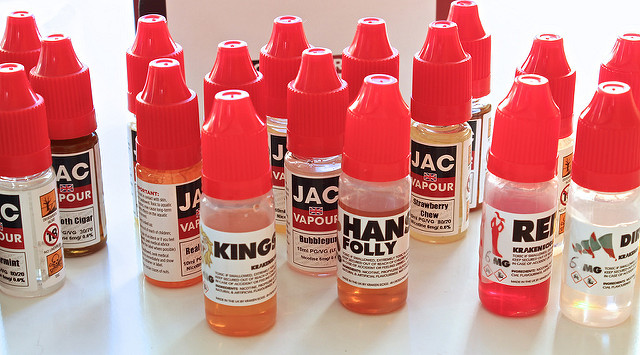
New findings published in the journal Tobacco Regulatory Science suggest that flavoured e-cigarettes appeal particularly to youth and young adults.
From the study's sample population, 99% of 12-17-year-olds and 95% of young adults said...
Share the Knowledge: ISSUP members can post in the Knowledge Share – Sign in or become a member

